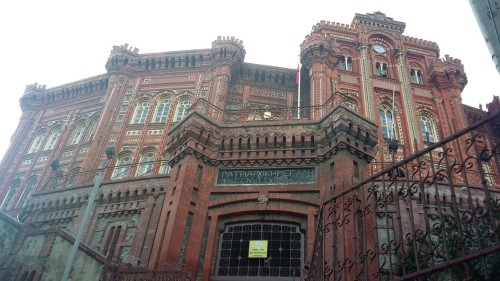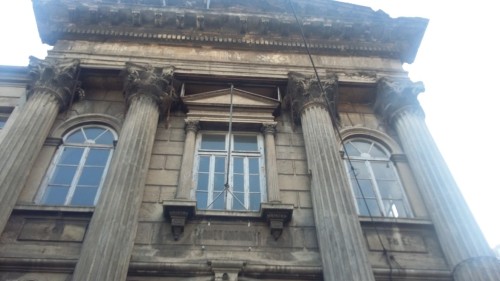
I have dreamed of living in Istanbul for as long as I can remember.
My desire and inexplicable force driving me towards this amazing city was to a large degree due to my archaeological and historical interest in the Byzantine past—owing to courses I undertook as an undergraduate student at the University of Cyprus, Department of History and Archaeology—and my personal readings of less academic nature.
Characteristically, the book of Alexandros Massavetas, ‘Constantinople: The City of Absences’ (2011) provides a historical account of the different districts of Byzantine, Ottoman, and modern Istanbul (especially focusing on the historical peninsula) from rather an experiential point of view, often creating vivid images for the reader. His attempt to record the history of this cosmopolitan city moves beyond a nostalgic and melancholic narrative of Constantinople’s Greek past, but he rather surrenders to the magic present of today’s Istanbul.
Nevertheless, one can clearly identify Massavetas’ concern about the rapidly changing face and character of the city in such a drastic—and often destructive—way as to not help it but wonder: can we still, to this day, trace any elements of Istanbul’s multinational and multilingual past? This social and historical division between the past and the present often seems unbridgeable to the visitor or at least to those that seek to unravel stories about the ethnic minorities (Greeks, Armenians, Jews).
Having this question in mind since moving to Istanbul in past September I have experienced this city in multiple ways, from immense excitement by the possibilities provided in social and cultural terms, but at times also having an overwhelming feeling of crowdedness—particularly in Istiklal Street—and secludedness by the realization of being unable to communicate in the same language with the locals—Turkish is the second official language in Cyprus but not having learned it has its obvious toll!
Being a short-term resident in Istanbul from Cyprus often has also its challenges. Given the political situation for almost five decades and the geographical dichotomy of the island between the North and South and its division in Greek-speaking and Turkish-speaking communities, I had prepared myself for having to put up with questions of national identity or even discrimination. To my pleasant surprise none of this happened and the people of Istanbul, especially the young and well-educated generation, share the same “European mentality” as the equivalent in any other modern city within the geographical and political limits of Europe. The city itself imposes to the visitor an artificial dichotomy, deriving from the historical, cultural, and political contradictions. Istanbul, being considered as a bridge between the East and West, due to its geographical position between Asia and Europe, creates a sense of almost mythical distance, for which one needs to wander and explore constantly, to expand their boundaries in a world of change.
So I had been unconsciously carrying this sense of natural boundaries and the loose definition of borderlines or even cultural and geographical limits greatly as an effect of my Cypriot nationality. But this has turned into a conscious subject of my research through my long involvement in the archaeological excavation project at the island of Samos in the Eastern Aegean. My work on the reconstruction of prehistoric connections between the East Aegean islands and western Anatolia, particularly through the ceramic evidence, is also reflective of this once again artificial dichotomy, as well as of modern political boundaries between Greece and Turkey.
While strolling around Istanbul, especially during my long weekend walks in Pera/Beyoğlu, Balat and Fener, along the Bosphorus and all the way up to Yeniköy, the question of modern national divide, archaeological boundaries and the surviving ethnic identities of the city’s minorities has troubled me. I was struggling to imagine or reconstruct in my mind the organisation of the Rum communities at the end of the 19th and after the mid-20th century, the former representing their flourishing cultural and economic period while the latter follows their decline. In order to somehow grasp the extent and size of these communities one should take note of the dozens of Christian Orthodox churches built at about the late 19th/early 20th century. Of the most known are the Aya Triada off Taksim square, the Ecumenical Orthodox Patriarchate in Fener and many small churches in the same area and Balat, the Ayios Fokas church in Beşiktaş, Panayia Koumariotissa in Yeniköy, Ayios Nikolaos on Heybeliada and so on.
In the search for more Greek remnants one should look for the remaining schools, of which the most known among the five remaining in a city that once had sixty schools are the Zografeion High School located just a few meters from the Istiklal pedestrian, and of course the famous Phanar Greek Orthodox School, which forms an architectural landmark in Fener.

Aside the churches and schools, one can identify the Greek presence—or rather absence—by the impressive, marble-constructed houses the majority of which today stand in ruins in the area of Fener, Balat, and Pera. Occasionally, you can see an inscription of the owner’s name and date above the door and the characteristic Ionian-style columns framing the entrance.

This sense of abandonment and absence is however contradicted by the active presence of Greek expats at Pera, either studying at one of Istanbul’s universities or working. It is bridged by cultural events, the sharing of knowledge and the creation of ties between the two communities. This newly-established cooperation of the last couple of decades is encouraging and the best way to achieve this is by using one’s senses. At Istos, an independent publishing house and cafe running since 2011 just off Istiklal, five minutes from ANAMED, you can always come across Greek-speaking customers, enjoy a Freddo Espresso (traditionally made in Greece and Cyprus) while reading one of the many books published in Greek, Turkish or even in both languages. Istos’ work aspires to replace the existing spirit of nostalgia among the Rum community with a communal effort in promoting the intellectual resources of the minorities of Istanbul, intermixing these elements with the creation of a modern give-and-take cultural consciousness. This is further achieved by the Rembetiko music group “Tatavla Keyfi” and their regular shows, as well as the traditional Greek dance lessons every Saturday where one can witness people of various backgrounds dancing together and enjoying the sounds and movements of a Greek tradition.
Once in Istanbul you should strip off your preoccupations of any sort, let yourself get lost in sounds and smells, mingle with locals and foreigners and try to visualise the past and the promising future in the search of an ever-changing identity. It might not be always feasible to trace elements of these past minorities in a tangible manner, but their presence is on the buildings, the music and sounds, the very air of Istanbul itself. You just need to keep your senses loose and your mind open!

